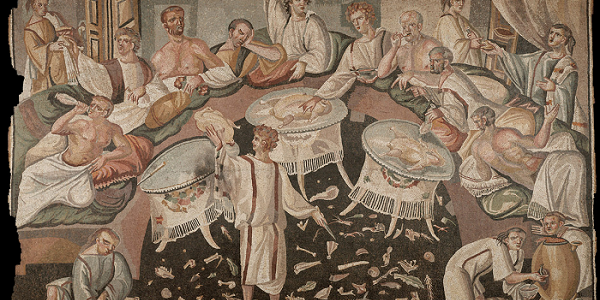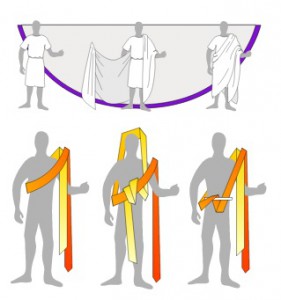
September 22, 2015, by Oliver Thomas
Dressing for a toga party
 The toga party is a staple of students’ first week at university. Our resident expert on ancient clothing, Dr Nikki Rollason, explains how to impress…
The toga party is a staple of students’ first week at university. Our resident expert on ancient clothing, Dr Nikki Rollason, explains how to impress…
So, after months of waiting you’ve finally arrived at the University of Nottingham to study at the Department of Classics. But how can you show this to the world? By dressing in probably the most recognisable item of dress from the ancient world, the Roman toga, at any and every Week One fancy dress party, of course! This post will show you how to do that so you can feel smug in the knowledge that your toga will be the most historically accurate one at the party.
First, some knowledge to impress new friends some background. The Roman toga was the item which marked out a Roman male citizen. The toga was a symbol of peacetime (Cicero said of his consulship cedant arma togae, ‘Let arms make way for the toga’), and it showed that the wearer was protected by the pax Romana when he travelled. It was also a mark of civilisation which foreigners and those who were exiled were not allowed to wear. The toga signified that a Roman was publicly engaged in the political and civic activities of peaceful citizen life: it was worn by magistrates and priests, clients and orators, even the emperor himself. But this was the purview of men, so women were probably not allowed to wear the toga. (Our sources on this are ambiguous: prostitutes may have been an exception.)
But how to create a toga costume? The one we’re recreating here is that worn by Augustus in the ‘Via Labicana statue’ (right), now in the Palazzo Massimo alle Terme in Rome.
- Firstly, wear underwear and a t-shirt underneath – your friends will thank you for it later in the night.
- Then you will need a (non-fitted!) bedsheet: this is the best starting-point, but the ancient toga was usually semi-circular and made of wool (which must have been cumbersome) or sometimes silk (which would show off your wealth, but might attract negative comments about your luxurious and immoral habits).
- As for colour, white is certainly how we think of togas. But a dark toga was worn when mourning, a purple one by the emperor, and one embroidered with golden threads by the triumphing general.
- Make sure the sheet is large enough – although the amount of material used to create a toga increased over time and changed the look of the drapery as a consequence, the toga was designed to cover the body from shoulder to ankle and wrap around it a couple of times folded, so go for a king-size.
 Fold the sheet along its length, so that you have a kind of flap about a quarter of the sheet’s original width – this will become important later.
Fold the sheet along its length, so that you have a kind of flap about a quarter of the sheet’s original width – this will become important later.- Next, get a friend to help – putting on the toga was a two-person (at least) job and wealthy Romans had specially trained slaves to drape their togas in the most fashionable way possible for the period they lived in.
- Stick both your arms out parallel to the ground, and have your friend drape your sheet with the flap showing and its open side facing left, over your left shoulder. One end of the sheet should reach down the left front side of your body to your ankles, with the left arm covered.
- You will then need to hold it in place while your friend brings the sheet across your back, with the ‘closed’ side of the flap nearest your neck.
- The sheet should go under your right arm, across your chest and then over your left shoulder again (this forms the sinus), leaving the remaining material hanging down your back on the left side; it is very important that you have enough material for this final part as its weight should balance out the rest of the material and allow you to wear your toga without it falling off.
- Finally get your friend to arrange your toga by (gently) pulling the very first layer of the toga (the first bit you draped which hangs down your front left side) so it hangs on your chest in a similar way to the statue. In the statue, Augustus has draped the fold over his head to indicate that he is sacrificing.
And there you have it – a toga fit for the first emperor.
Image credits:
Top: mosaic from the Eastern Roman empire, perhaps 5th century CE, (c) Le Chateau de Boudry, reproduced here under principles of Fair Use.
Middle: (c) Ryan Freisling, CC license via Wikimedia Commons.
Bottom: (c) LadyofHats, CC license via Wikimedia Commons.

Thanks to Nikki also for pointing me to this picture of Mark Bradley sporting imperial purple (image (c) Helen Frost). One of many reasons to follow us @UoNClassics